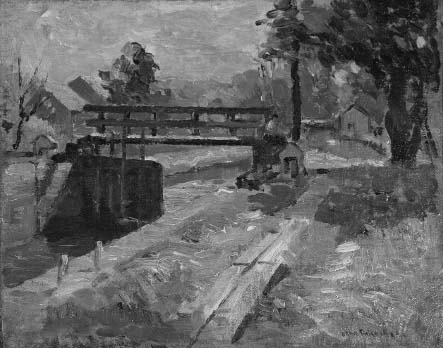The Delaware Canal (19 page)
Read The Delaware Canal Online
Authors: Marie Murphy Duess

Houses like this one located on the Delaware River are reported to have been used as lookout locations to watch for slave hunters or militia crossing from New Jersey. If seen, an alert would be sent into town to move or hide the fugitive slaves.
Author's collection
.
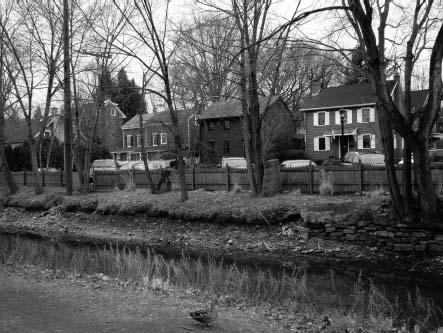
A row of quaint houses on Canal Street in Yardley overlooks the now peaceful waterway.
Author's collection
.
Chapter 10
The Canal's Worst Enemy
From Freshets to Floods
The Delaware Division Canal and the Lehigh Navigation Canal endured both freshets and floods, and did so frequently. Melting snow and ice coming from the hills and mountains surrounding the canal caused the streams and creeks to overflow several times a year. Although both the Delaware and Lehigh Canals were built to cope with these freshets, there were years that spring rains and raging storms created greater flooding than the canals were designed to handle, causing breaches and damaged banks.
The Delaware River floods were not as frequent as the freshets, but when the river did flood, it was usually catastrophic for the river towns. One of the major flaws of the Delaware Division Canal was the fact that it was built so close to the river.
The first freshet to damage the canal was in March 1832, not long after it had opened. In January 1839, a violent storm descended on New York, New Jersey, Delaware and Pennsylvania, causing flooding across those states and major damages to the canals, except for the Lehigh Navigation Canal, which suffered very little from the storm.
The Delaware Canal suffered major breeches when the flood reached twenty-two feet above the low-water mark. It flooded all the lower levels of the canal, swept off aqueducts and filled the canal with soil from the destroyed banks.
The dam at Easton was almost completely destroyed, but the local residents and canal workers moved as one force to rebuild it, even during a raging current in the cold month of January. But the cost of repairing the canal that month was overwhelming.
The flood of 1841, caused by heavy rains melting the snow in the mountains, nearly destroyed both the Delaware Division and Lehigh Navigation Canals. It carried away locks, dams, houses, boats and bridges. This January flood was especially devastating to the Lehigh Navigation Canal, which had escaped major damage in 1839. The winter flood was followed by more that same year, in June, July and August, and as quickly as the damage was repaired, there was more damage to be fixed.
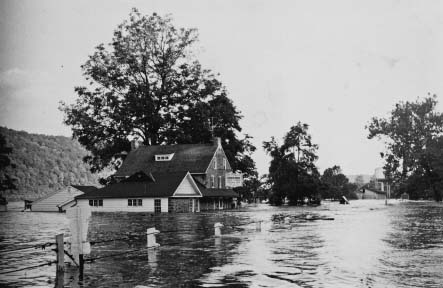
Floods from the Delaware River frequently put the canal out of commission for weeks, months and even years. This photo was taken near the River House (Chez Odette's) and shows the canal completely underwater.
Courtesy of the New Hope Historical Society
.
The LC&N called Josiah White out of semiretirement and employed an engineer, E.A. Douglas, to determine the entire damage. It took months to repair both waterways, and that year toll collection dropped to $64,974.93 as the expenses rose to $109,338.81.
68
The floods of 1841 nearly bankrupted the LC&N.
Faults in the construction of the Delaware Divisionâshortcuts taken during its constructionâcontributed to the damages. After the floods of 1841, guard gates were incorporated into the design of the canal, and they did seem to relieve damage from flooding to some extent. However, the region was still plagued by floods: in the spring of 1843, in the fall of 1845 and again in 1850, 1852, 1862 and 1868. All of this flooding interrupted boating from a month to several months. During some of these floods, families lost their homes, businessmen lost their businesses and, sadly, some lost their lives. When the waters subsided, logs, boats, houses, bridges and dead livestock littered the river towns along the Delaware. The early twentieth century wasn't kinder with high waters, floods and freshets in 1901, 1902, 1904 and 1906.
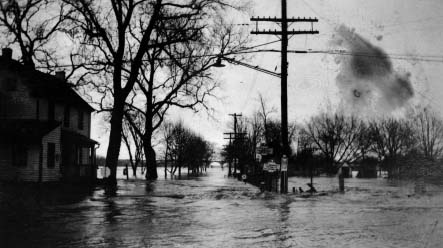
This photo shows the Yardley Inn underwater during one of the many floods that plague Bucks County towns and boroughs even to this day.
Courtesy of the Yardley Inn
.
In March 1936, when the transfer of the Delaware Canal to the state was being discussed, a statewide storm produced disastrous floods in all of the river valleys. And repairs were necessary once again when Hurricane Diane swept through eastern Pennsylvania and caused yet another flood that took a heavy toll in the form of human life and property.
In fact, the Delaware Valley is vulnerable to this day, with heavy flooding from the Delaware River, brought on primarily by overflows from two New York reservoirs and a mountain lake in Pennsylvania.
Chapter 11
Beautiful Impressions
The Delaware Division Canal passes through some of the most picturesque landscapes in the United States. In some places it is breathtaking. The canal meanders through beautiful countryside, sandwiched between the Delaware Canal on one side and neatly laid-out farms, charming little colonial villages and wildflower-laden fields on the other.
Its beauty was not lost on some of the most renowned American impressionists of the nineteenth and twentieth centuries. Members of what are called Pennsylvania impressionists and the New Hope School, these artists came from many parts of the country to Pennsylvania to study and teach at the Pennsylvania Academy of Fine Arts in Philadelphia. The circle was formed in 1898, when many of them made their homes in the tiny hamlets and villages along the Delaware Canal and established their studios in and around New Hope.
A noted painter and critic of the time, Guy Pène du Bois, declared that their work was “our first truly national expression.” It is impossible to say which of them is the most famous, for all have made their marks in American collectors' hearts. They reflect life as it was in small-town America during the late 1800s and the early 1900s, and they portray the beauty of the landscape before paved roadways and unsightly telephone and electric poles and wires blemished the views of magnificent barns, beautiful rivers and Victorian villages.
The New Hope Artists
Edward W. Redfield may have won the most awards of any American artist except John Singer Sargent. Redfield would tie his canvasses to trees in the brutal winter weather in order to paint a perfect winter scene, yet his spring and summer paintings are just as moving and his city skyline paintings are renowned. After studying in Philadelphia, France, Italy and England, he settled in Centre Bridge in 1898. He was one of the first American artists to paint on location and complete a painting in one session.
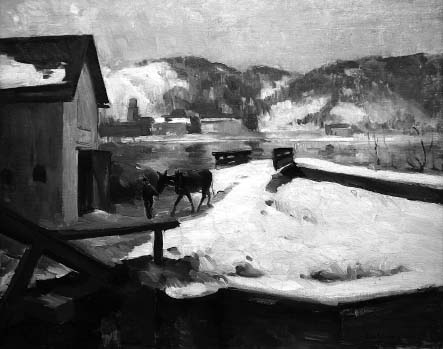
The New Hope Circle of American impressionists was fascinated by the Delaware Canal and often used it as a model for its paintings and sketches. This is John Fulton Folinsbee's
Mule Barn. Courtesy of Gratz Gallery, New Hope, PA
.
William Langson Lathrop was instrumental in establishing this special community of artists when he moved to Phillips Mill in 1899. He brought his students to his studio, and his wife, Anne, hosted weekly teas for his colleagues. He never took formal training, but instead learned from many artists he admired, and, in turn, he mentored several members of the New Hope School's first and second generation of artists. He was beloved and greatly missed when his boat sank in Long Island during a hurricane in 1938 and he drowned.
Daniel Garber, who lived in Lumberville, was born in Indiana and settled on the Cuttalossa Creek. He taught at the Pennsylvania Academy of the Fine Arts, and his work won numerous national awards.
After visiting Lathrop's New Hope home, Florence and Henry Snell, both acclaimed artists from England, relocated to the village. Florence won the McMillan landscape prize from the Association of Women Painters and Sculptors in New York in 1913. Henry taught at the Philadelphia School of Design for Women from 1899 to 1943.
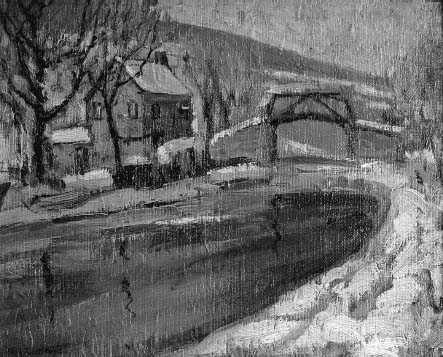
Fern Coppedge,
Canal in Winter. Courtesy of Gratz Gallery, New Hope, PA
.
Fern Isabel Coppedge may be the artist who painted the largest number of Bucks County landscapes, although some of her art was produced in Gloucester, Massachusetts, when she spent summers there. Like Redfield, she tied her canvasses to trees during winter storms, and she was fastidious in her attention to the effects of changing light on a landscape. She became a member of the “Philadelphia Ten,” a group of women painters who banded together to show their work in exhibitions once a year. In April 1922, the
Christian Science Monitor
published this statement about this group of American artists:
While a certain coterie of men artists are striving for “atmosphere” and find in harshness of subject and technique what purports to be the strength and power of masculine intelligence, the traditions of the decorative and beautiful are being perpetuated quietly, conscientiously, by the sisters of the brush
.
69
